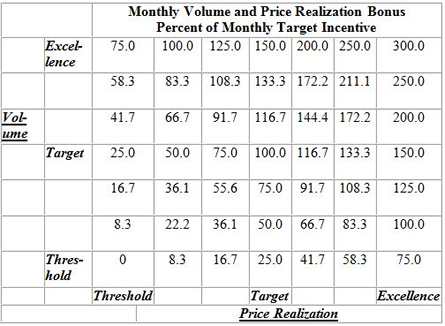Yesterday, consultant David Cichelli talked about hurdles, modifiers, and multipliers for sales compensation. Today, his take on using matrices, plus an introduction to a new compensation webinar you won’t want to miss.
Matrices for Sales Comp
Use a matrix when salespeople have concurrent accountability for two competing measures, says Cichelli, who is senior vice president at the Alexander Group. His remarks came at the WorldatWork Total Rewards Conference and Exhibition held recently in Philadelphia.
The payout matrix provides improved payout as performance on both measures improves. There is a double threshold and a double cap. A typical example of this is the competing nature of sales volume and price realization. Clearly, if the only measure is volume, salespeople will be incentivized to make sales at any price, leaving the company with lots of unprofitable sales.
Winning Compensation Scorecards—webinar coming May 12! Learn more.
And, conversely, if the only measure is price realization, the company will get a small volume of sales at full price—not a good situation either. So the matrix is a solution that helps balance the two factors. Only by doing well on both scales can the salesperson maximize his or her payout.
Example: Bonus Matrix

Hurdles, modifiers, and matrices—these are three more things to add to the list of comp and benefits’ daily challenges.
“Maintain internal equity and external competitiveness and control turnover, but still meet management’s demands for lowered costs.” Heard that one before, or something like it? What, exactly, should you be measuring in your compensation program—and how?
If you’ve been asking yourself these questions, we’ve got a webinar you won’t want to miss on May 12.
Winning Compensation Scorecards: What and How to Measure for Effective Results
Webinar coming Monday, May 12, 2014
10:30 a.m. to Noon Pacific
Are you applying accountability and logic to back up your compensation decisions? Without an effective compensation scorecard in place, you run the risk of having to strong-arm your organization into making responsible and equitable choices.
Compensation is probably one of your organization’s largest expenditures, and probably one of the hardest to manage. Why? Because there is no “one-size-fits-all” answer. Trouble spots include over- or underpaying for positions relative to the market, inflated salaries that aren’t in line with the revenue the organization is generating, and the list goes on.
Compensation scorecards are a highly effective tool for improving transparency and holding managers accountable for how they apply financial resources. To ensure that merit increases and incentive compensation align with departmental performance and your organization’s overall compensation strategy, attend our upcoming webinar. Seasoned professionals will explain key steps and proven methods for creating a winning compensation scorecard.
Participate in this interactive webinar, and you’ll learn:
- Why a compensation scorecard is so important for every organization, regardless of its size
- The three essential steps in creating a winning compensation scorecard
- How to incorporate base pay and incentive actions into your scorecard for the most meaningful results
- How to connect the scorecard to other factors such as performance management, promotions, turnover, and hiring to provide rich context
- How to introduce a scorecard to get buy-in and accountability
- Case studies about what to avoid when introducing a compensation scorecard
- And much more!
Don’t miss it—claim your spot today!
